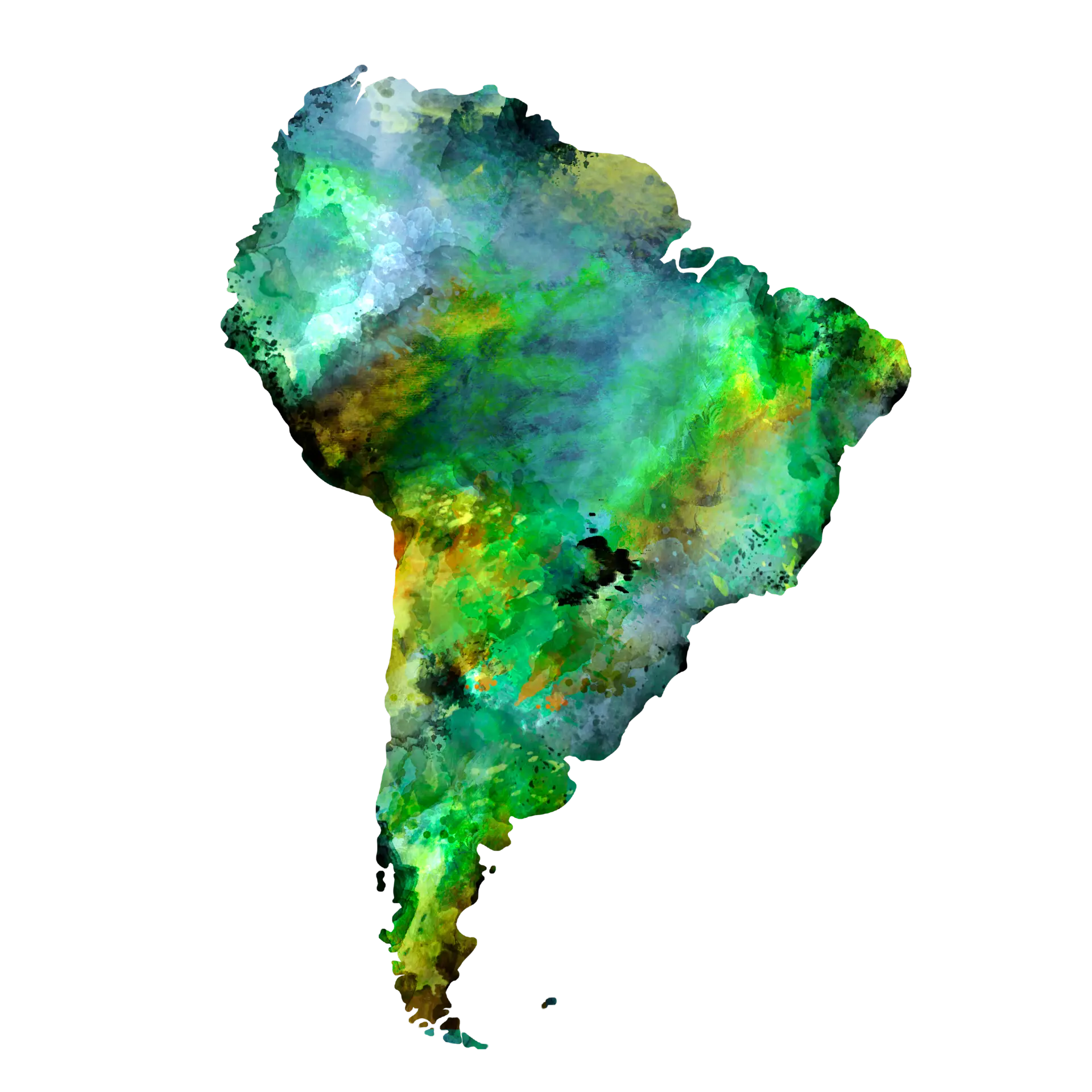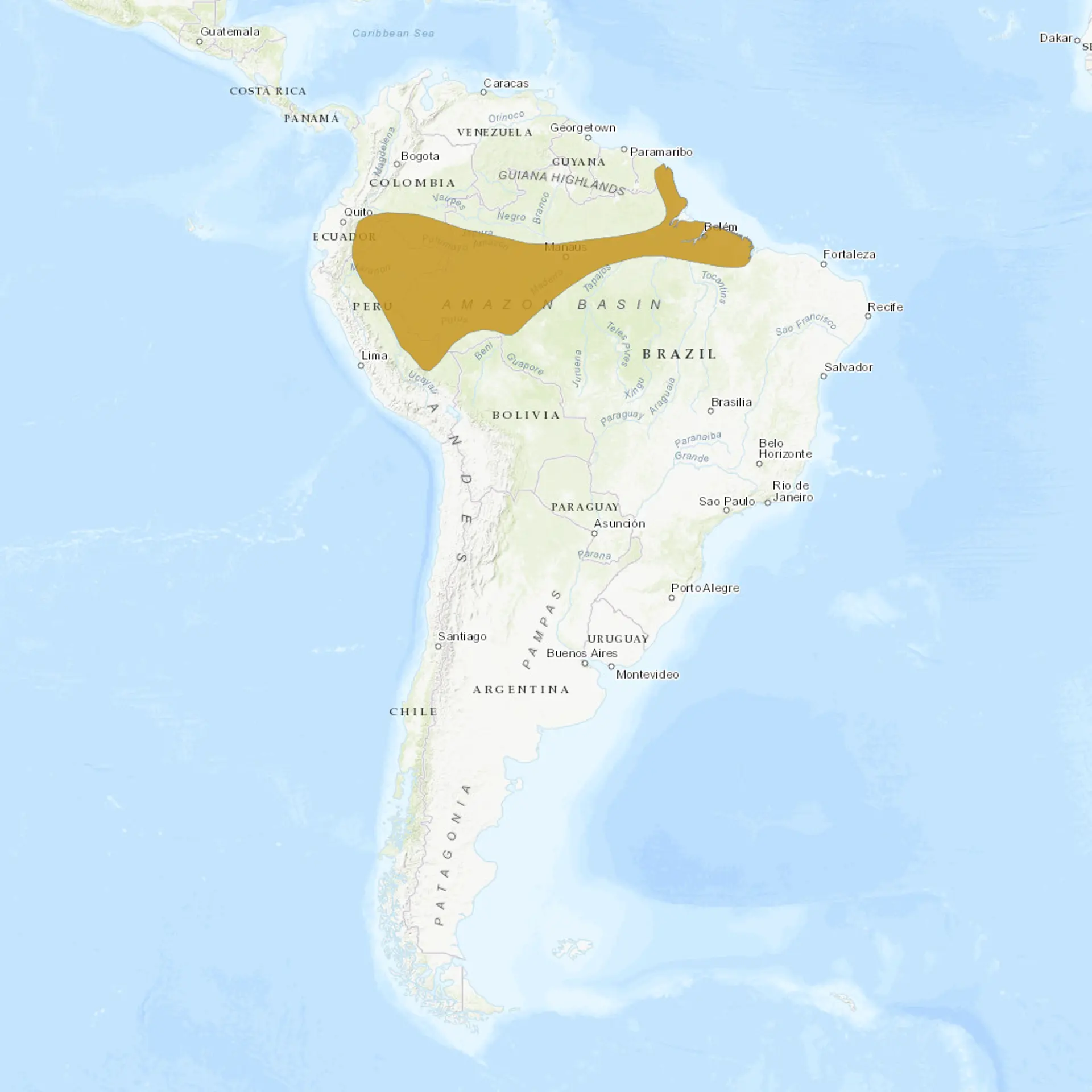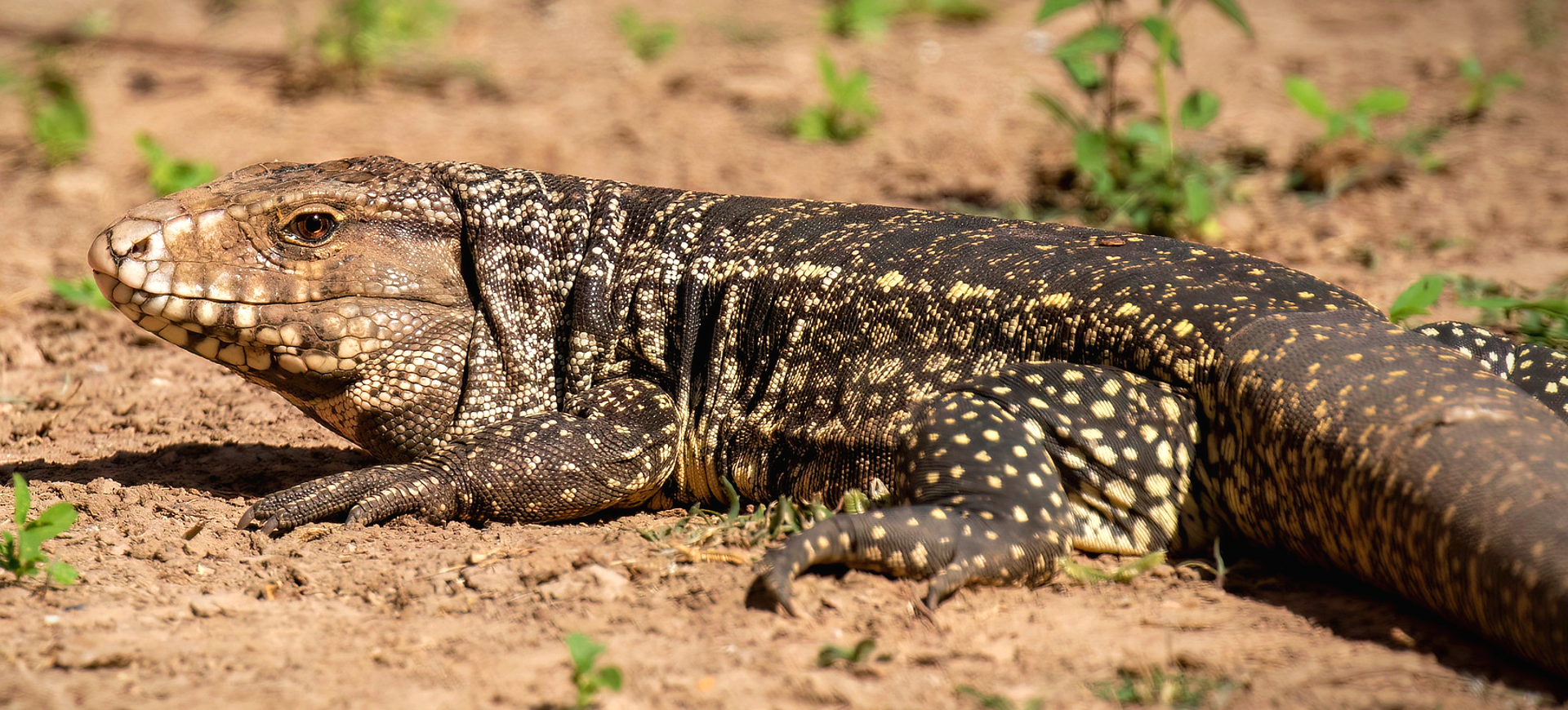Overview
The Northern Caiman Lizard (Dracaena guianensis) is a colorful lizard in South America. Its striking coloration consists of a vibrant red-orange head, a green-yellow body, and a thick, robust brown or black tail. It is often compared to crocodiles and iguanas due to their physical similarities. It features a large, flat head with powerful jaws and a strong, heavy tail that aids swimming, reminiscent of a crocodile. Moreover, it possesses the scaling and body structure common to many iguana species.
Its size is substantial among lizard species, typically ranging from 2 to 4 feet long when mature. The tail accounts for more than half of the Northern Caiman Lizard’s total length, acting as a vital tool for its aquatic lifestyle. This semi-aquatic lizard spends substantial time in freshwater habitats such as swamps and rainforest waterways. The species possesses fully webbed back feet, making it a skillful and efficient swimmer. Despite its name, the Northern Caiman Lizard is not a caiman or crocodile but earns its name due to its crocodilian appearance and similar habitats to caimans.
The Northern Caiman Lizard is an active predator, feeding primarily on snails, crustaceans, and occasionally small fish. It has a specialized diet and has evolved powerful jaws capable of crushing the hard shells of its prey. Despite its powerful build and predatory nature, this lizard is predominantly diurnal and passive towards humans unless provoked.
Current distribution:
The Northern Caiman Lizard's distribution spans several South American countries, primarily in the Amazon Basin. It is found in Brazil, Colombia, Ecuador, Peru, and the Guianas, where it inhabits a variety of freshwater ecosystems. This distribution is largely influenced by the availability of suitable habitats that provide food, shelter, and breeding grounds. However, its range is increasingly fragmented due to habitat destruction and environmental changes.
Populations are more abundant in areas with minimal human disturbance, highlighting the impact of habitat degradation on its distribution. The species is often observed in protected areas and remote regions where natural habitats remain intact. Its presence indicates healthy freshwater ecosystems, making it a valuable species for ecological monitoring. Continued efforts to protect these areas are essential for maintaining viable populations of the Northern Caiman Lizard in the wild.
Physical Description:
The Northern Caiman Lizard is a visually striking reptile with a distinctive armored body covered in tough, overlapping scales. Its coloration is predominantly green, providing camouflage among the leaves and branches of its forest habitat. The head is often a contrasting reddish-orange, especially in mature males, which can serve as a visual cue during mating season. Its strong, muscular tail is laterally compressed, enhancing its swimming abilities.
The lizard’s limbs are powerful and well-adapted for climbing and swimming, and its long claws aid in gripping surfaces. It has a broad, flat head with large jaws capable of crushing hard-shelled prey, such as snails and crustaceans. Adults can grow quite large, with some reaching lengths of over four feet, including the tail. This robust physique, combined with its striking coloration, makes the Northern Caiman Lizard a fascinating subject of study in herpetology.

Lifespan: Wild: ~10 Years || Captivity: ~20 Years

Weight: Males: 4.4-11 lbs (2-5 kg) || Females: 2.2-6.6 lbs (1-3 kg)

Length: Males: 36-48 in (91-122 cm) || Females: 30-42 in (76-107 cm)

Height: Males: 12-18 in (30-46 cm) || Females: 10-16 in (25-41 cm)

Top Speed: 10 mph (16 km/h)
Characteristic:
Native Habitat:
The Northern Caiman Lizard is native to the tropical regions of South America, particularly in countries like Brazil, Colombia, Ecuador, and Peru. It thrives in freshwater habitats such as rivers, streams, swamps, and flooded forests, where it can easily access terrestrial and aquatic prey. The availability of water bodies and dense vegetation for cover and basking sites influences the lizard’s habitat selection. These environments provide the necessary resources for feeding, thermoregulation, and breeding.
The Northern Caiman Lizard prefers habitats with abundant aquatic vegetation and overhanging branches, which offer shelter and basking spots. It is often seen basking on branches or logs near the water, retreating into the water when threatened. The Northern Caiman Lizard is highly adapted to its semi-aquatic lifestyle, with physiological and behavioral traits that support its dual existence in water and on land. Conservation of these habitats is crucial for the species’ long-term survival.
Climate Zones:
Biomes:
Biogeographical Realms:
Continents:
Diet:
Diet & Feeding Habits:
The Northern Caiman Lizard primarily preys on aquatic snails, utilizing its powerful jaws to crush their shells. Its diet also includes a variety of other invertebrates, small fish, and occasionally fruits and vegetation. This dietary flexibility helps the lizard adapt to different environmental conditions and food availability. In captivity, they are often fed a diet that mimics their natural intake, including snails, shrimp, and specialized reptile food.
The lizard’s foraging behavior involves terrestrial and aquatic environments, showcasing its adaptability. It often hunts in water, using its swimming skills to capture prey. On land, it searches through leaf litter and under logs for hidden invertebrates. This opportunistic feeding strategy is crucial for survival in the wild, where food resources can be unpredictable.
Mating Behavior:
Mating Description:
The Northern Caiman Lizard exhibits a mating system characterized by seasonal breeding, with courtship and mating typically occurring during the rainy season. Males become more territorial and display aggressive behaviors to establish dominance and attract females. Courtship involves head-bobbing, body displays, and chasing, culminating in copulation once a female accepts the male. The female lays a clutch of eggs in a secure, hidden location, often burrowing into soft, sandy soil to deposit them.
The incubation period for the eggs lasts approximately 150 to 180 days, depending on environmental conditions such as temperature and humidity. Hatchlings emerge fully developed and are immediately independent, capable of hunting and fending for themselves. Parental care is absent, with the young relying on instinctual behaviors to survive in their early stages of life. This reproductive strategy ensures the continuation of the species, even in fluctuating environmental conditions.
Reproduction Season:
Birth Type:
Pregnancy Duration:
Female Name:
Male Name:
Baby Name:
Social Structure Description:
The Northern Caiman Lizard is generally solitary, with individuals coming together mainly during the breeding season. Outside of this period, they maintain territories and avoid close interactions with others of their species. Territorial disputes among males can be intense, involving displays and physical combat to establish dominance. Juveniles are also solitary and must fend for themselves from birth, relying on their instincts for survival.
In captivity, these lizards may exhibit more social tolerance, but adequate space is essential to prevent stress and aggression. Understanding their social behavior in the wild aids in improving captive care and management practices. Observations indicate that basking sites are critical for thermoregulation and social interactions. Environmental enrichment in captivity, such as climbing structures and water features, can enhance their well-being.
Groups:
Conservation Status:
Population Trend:
The Northern Caiman Lizard is currently classified as Least Concern by the IUCN, but its population trend is decreasing due to ongoing habitat loss and degradation. Specific population numbers in the wild are not well-documented, making it difficult to assess the exact impact of these threats. The species is relatively well-represented in captivity, providing opportunities for study and conservation breeding programs. Efforts are underway to better understand and protect wild populations through field research and habitat conservation initiatives.
Habitat destruction, particularly deforestation and water pollution, poses significant threats to the Northern Caiman Lizard. These activities fragment and lose crucial habitats, directly affecting the lizard’s ability to find food and suitable breeding sites. Conservationists emphasize the importance of protecting freshwater ecosystems and implementing sustainable land-use practices. Public awareness and education campaigns are also vital to garnering support for conservation efforts.
Population Threats:
The primary threats to the Northern Caiman Lizard include habitat destruction, deforestation, and water pollution. Expanding agricultural activities and urban development in South America leads to the loss of essential habitats. Additionally, industrial and agricultural runoff pollution contaminates freshwater systems, impacting the lizard’s health and food sources. Illegal capture for the pet trade also poses a threat, reducing wild populations.
Climate change further exacerbates these issues by altering rainfall patterns and water availability, which is crucial for the lizard’s survival. Conservation measures focus on protecting and restoring natural habitats and regulating the pet trade. International cooperation is essential to address these transboundary environmental issues. Increased research efforts are needed to monitor population trends and develop effective conservation strategies.
Conservation Efforts:
Conservation efforts for the Northern Caiman Lizard include habitat protection, environmental education, and legal regulations. Protected areas and reserves play a crucial role in preserving the natural habitats essential for the species’ survival. Environmental education programs aim to raise awareness about the importance of conserving freshwater ecosystems and the species that inhabit them. Legal regulations help control the pet trade and prevent over-exploitation of wild populations.
Collaboration between governments, NGOs, and local communities is vital for successfully implementing conservation initiatives. Research projects focus on understanding the species’ ecology, behavior, and population dynamics to inform conservation strategies. Restoration projects aim to rehabilitate degraded habitats and improve the quality of freshwater ecosystems. These combined efforts are essential for ensuring the long-term survival of the Northern Caiman Lizard in the wild.
Additional Resources:
Fun Facts
- The Northern Caiman Lizard has a unique ability to change color slightly to blend with its surroundings.
- It can stay submerged underwater for up to 15 minutes.
- This species uses its strong tail for both swimming and defense.
- The lizard’s diet primarily consists of hard-shelled prey like snails and crustaceans.
- Northern Caiman Lizards are excellent climbers, often basking on branches of overhanging water.
- Their powerful jaws are specifically adapted to crush the shells of their prey.
- They can be elusive, often diving into the water to escape predators.
- These lizards are known for their distinctive, heavily armored scales.
- The species is often confused with the related tegu lizards due to similar appearances.
- They play a significant role in controlling snail populations in their native habitats.










